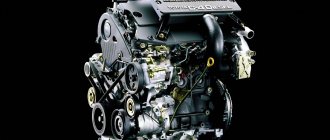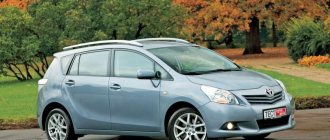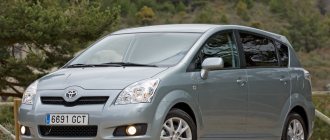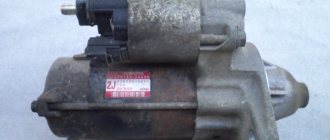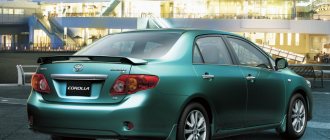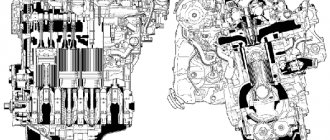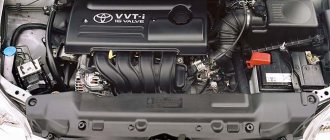Toyota Corolla Verso is a compact minivan that appeared in 2001. From its predecessor, the Corolla hatchback, the car inherited only the name and wheelbase. The Toyota Corolla minivan allows you to comfortably transport 7 adults. According to reviews, the Toyota Corolla Verso is one of the best family cars, compact and safe.
The lineup
It is not easy to distinguish the 2nd generation pre-restyle Corolla Verso (above) from the updated one (below).
The first generation of minivans produced by the Toyota concern appeared in Japan in 1997 and was called Toyota Spacio. The plant was tasked with making an affordable urban minivan. The characteristics of the Toyota Spacio have been fully adapted for families: the second row of seats has been transformed, and the level of safety has been increased. It was hoped that the car would be used mainly by women, so there was a display on the dashboard instead of dials.
In 2001, the Toyota Corolla Verso was released, designed for the European market. If the Spacio is exclusively a right-hand drive car, then the Corolla Verso is left-hand drive. The 1st generation model E110 was produced with 1.6 and 1.8 liter engines. The 1.6-liter engine had a manual transmission, and cars with a 1.8-liter engine were equipped with an automatic transmission.
Toyota Corolla Verso showed good sales dynamics in 2002, so the next generation of the car was released in 2004, it was even more aimed at European consumers. They produced cars with gasoline (1.6 and 1.8 liters) or diesel (2 and 2.2 liters) engines.
Corolla Verso before update
In the second generation E121, you can choose from a five-speed manual or robotic gearbox. This version of the Corolla Verso was produced until 2006, until the 2nd generation of the car was restyled, as a result of which the Toyota Corolla Verso R10 appeared in 2007.
And in 2009, based on the 2007 Corolla Verso, they developed a compact minivan model called the first generation Toyota Verso R20.
car review Toyota Verso Minivan
Such familiar combinations as Toyota Yaris Verso, Toyota Corolla Verso and Toyota Avensis Verso are no longer relevant. Now it’s just Toyota Verso – an independent model that does not belong to any “communities”.
The basis for the new Toyota Verso minivan was the Toyota Auris hatchback. Of course, the minivan is larger than its predecessor. The wheelbase has increased by almost 28 cm. But if you compare it with the Toyota Corolla Verso, the dimensions have changed slightly, literally a couple of centimeters in each direction. And, nevertheless, it significantly added comfort. Five adults and two children, taking with them everything they need, can feel comfortable.
With seven passengers, the Verso's trunk may seem small - only 155 liters. However, if you only need to accommodate 5 people in the car, the trunk acquires a quite serious volume of 1645 liters. The designers considered it unnecessary to remove “additional” seats from the cabin; however, they are lowered, turning into a flat floor, and do not interfere with loading the trunk. But even 155 liters is not so little, considering that the interior of the Toyota Verso minivan is simply full of all kinds of shelves and drawers on which you can stuff a lot of necessary and not so necessary property. Everyone sitting in the cabin, regardless of seat, is provided with maximum visibility. And for parents there is a special “parental” mirror, in which you can see what the children are doing on the road. Lots of space and everything is visible - what more is needed for a family car! Well, for example, such pleasant little things as good sound and noise insulation.
Masato Katsumata, the developer of the Toyota Verso, says that the appearance of the car demonstrates stability. It's hard to disagree with this. From a distance, you are unlikely to determine that this is a new Toyota Verso, and not, for example, a Toyota Corolla Verso and a Toyota Avensis Verso. By the way, the front part of the body of the new product is very “Avensis”. But now there should be fewer problems with identification. The manufacturer plans to supply only the new Toyota Verso to the European market.
There are as many as five engine options – three diesel and two petrol. But only gasoline ones are officially supplied to Russia - volumes of 1.6 and 1.8 liters. Of course, 1.6 liters is clearly not enough for such a car - you feel that the engine is working at the limit. But with a 1.8-liter engine, the car doesn’t feel bad at all - acceleration to hundreds will take 10.4 seconds, and the top speed will be 190 km/h. Gasoline consumption is promised to be very low – on average ~7 liters per 100 km. In both versions, the car is equipped with a six-speed gearbox. And for the 1.8 engine, the MultiDrive S variator is also offered. The variator works wonders both on difficult serpentine roads and in city traffic. It is practically a seven-speed gearbox.
There are also several wonders that were not previously offered to Europeans: an electronic steering damper - which prevents the vibration of the steering wheels from reaching the driver’s hands and power steering with the possibility of auto-correction - it is assumed that if you turn the steering wheel too much to enter a turn, it will provide resistance.
The safety of the driver and passengers of the new Toyota Verso is also at its best. Even the basic equipment includes active head restraints on all seats and airbags for each, and for the driver there is also an additional one – a knee airbag.
In general, everything in the new car is not bad. There aren’t enough stars in the sky and it doesn’t offer revolutionary innovations, but it performs its role as a family minibus regularly and takes care of the household. The Toyota Verso is just being assembled in Turkey. This may not confuse everyone, but not everyone wants to pay the “Japanese price” for a “Turkish assembly”, given the already sad experience with the “Turkish” Toyota Corolla.
Appearance Verso R10
To ensure that high sales of the Toyota Corolla Verso in 2005-2006 did not decrease, the minivan was restyled in 2007. The appearance of the car received slight changes, the car became 10 mm longer due to a new type of bumper, thanks to which the car's design became more sporty.
Corolla Verso R10
The front optics and turn signals have undergone changes; they have become of a different shape. From the back it is also easy to recognize the 2007 Corolla Verso: a chrome strip has appeared above the license plate, and the taillights have changed their shape.
Driving impressions
83%
car owners will buy this car again!
- 73% Road tests
- 62% Reliability
- 83% Driver satisfaction
Drivers looking for a powerful car won't like the Corolla Verso. But for those who are looking for a comfortable, reliable vehicle that can accommodate six passengers, a compact van is suitable. There are sporty options in the family minivan class, but the Verso offers a smooth ride and ease of use. It may seem that the brakes are “dumb”, but they work in a timely manner. The advantage of the car is good visibility, without which it is difficult to move in heavy city traffic. The car sticks to the road, confidently entering turns.
Verso salon restyling
The Toyota Corolla Verso 2007, like previous versions, has 7 passenger seats. The second row of passenger seats can be easily removed, freeing up space in the trunk. Thanks to the Flat-7 interior transformation system, more than 20 seating options are possible. Unlike previous versions, the seat upholstery is more practical. The R10 version now has separate climate control.
The salon is simple and functional
Thanks to the high seating position, this model is comfortable to sit behind the wheel of, and the driver gets a wide view. The dashboard is different from previous builds of the car. Previously, the speedometer was located in the center, and in its circumference there was an on-board computer screen. In the R10 model, the on-board computer screen is located in the center, and the speedometer and tachometer are equal in size.
Technical characteristics of 2nd generation
The dimensions of the 2nd generation Toyota Corolla Verso are almost the same for the 2003 and 2007 models. And equal to 4360 mm in length, 1770 mm in width; in 2003, the height of the Corolla Verso was 1620 mm, and in 2007 it increased to 1660 mm. The weight of the car depends on the configuration and varies from 1355 to 1435 kg.
Bright instrument panel. For girls?
The ground clearance of the second generation Toyota Verso is about 153 mm. Be careful, a loaded car loses at least 2 centimeters in ground clearance. The wheelbase is 2750 mm. The trunk volume in the Corolla is 423 liters; it can be increased by folding down one or two rows of passenger seats.
The volume of the Toyota Verso fuel tank is 60 liters. for model R10 and 70 l. for E121. Toyota Verso fuel consumption ranges from 7.5 to 9.9 liters per 100 km.
Engine and transmission
Toyota corolla verso 2007 and 2003 is equipped with a 1.8 liter 1ZZ-FE engine with a power of 129 horsepower. Toyota Verso was produced with two types of transmissions: Manual 5 or Robot. The robot is a middle option between automatic and manual, but in reality this type of transmission has more disadvantages than advantages.
The motor has a torque of 170 N*m.
Toyota Corolla Verso R10 configurations
Toyota Corolla Verso 2007 is available in two trim levels: Sol and Terra. Terra is the minimum required set of car functions, Sol is an expanded one.
The basic configuration of the Corolla Verso has everything necessary for comfortable travel for a large family: air conditioning, heated driver and front passenger seats, and an audio system. Safe trips are made by the presence of an ABS system and brake force distribution, high-quality airbags, and disc brakes. The Terra package also includes wheels of the appropriate type and size, heated side mirrors, steering column adjustment, and a remote central locking control system. An anti-theft system will protect your car from theft.
Corolla Verso interior layout
The Sol package for the Corolla Verso is complemented by functions that make it easier to drive the car in difficult conditions: vehicle stability control system, traction control system, electronic brake booster. In the Sol configuration, travel is more comfortable due to the presence of climate control and cruise control, an armrest for the front seats, and a leather steering wheel. Driving a Toyota Verso in the Sol configuration is more pleasant, thanks to the presence of fog lights, an electrochromic rear view mirror, a rain sensor, and alloy wheels.
Details about the Toyota Corolla Verso
Interior and exterior
Externally, the Corolla Verso resembles the classic Corolla, but has more expressive details. Expressive wheel arches and a well-designed grille with bumper hint at a different class. The wide “shoulders” give the car charisma. Unlike other representatives of the class, the Corolla Verso seats seven people. Unique to the class is the ability to completely fold the five rear seats at the touch of a button. If you need additional space, you won't have to remove the seats. The quality of finishing materials has improved. The interior elements correlate well with each other. Straightforward styling makes it easier to use the necessary parts and devices. The driver can easily find a comfortable position behind the wheel, which can be adjusted according to needs. The driver's seat is also adjustable. Top trim models will offer steering wheel-mounted stereo controls. Cars with satellite navigation can be equipped with a display that shows the position of the body when entering corners. Luggage compartment volume varies from 91 to 779 liters.
Basic equipment
How we tested the Toyota Corolla Verso
The following models are presented to the buyer: T2, T3, T Spirit, T180. The base T2 model received flush-folding seats, power front windows, push-button ignition, a leather-wrapped shift lever, airbags, anti-lock brakes with brake force distribution, remote door locking and air conditioning. The T3 model, later replaced by the SR, comes with 16-inch alloy wheels, heated side mirrors, power rear windows, cruise control, automatic air conditioning and rain-sensing windshield wipers. The top-of-the-line T-Spirit adds a DVD player and roof rails. The T180 diesel model comes with tinted glass and larger wheel rims.
Advantages and disadvantages
Like all cars, the Toyota Verso has advantages and disadvantages. The advantages of the car include:
- Spacious and compact. For a minivan, the Toyota Corolla Verso has small dimensions, but the car can fully accommodate 7 people.
- Reliability. It's a Toyota)
- Safety. The car is equipped with 7 airbags, and there are ISOFIX mounts for child car seats. The advantage of the 2007 Verso is that it has 5 stars in the Euro NCAP safety test.
- Low cost of consumables.
- Easily transformable interior, if necessary increases the volume of the trunk.
- Relatively low gasoline consumption.
Verso's pillows are fine
The main disadvantage of the Toyota Verso is the gearbox. The manual transmission lacks a 6th stage, and the robotic transmission requires serious modifications, since the gear shift speed is five times lower than that of a manual transmission.
Comparison of Toyota Corolla Verso with competitors
The main competitors of the Toyota Corolla Verso are the Mazda 5 and Opel Zafira. Despite the fact that the Toyota is a little shorter than the Opel, only children can sit comfortably in the third row of the Verso. The middle row in all models is movable and equipped with folding tables. Toyota's dashboard is centrally located, which can cause inconvenience. In terms of quality of materials, Verso is inferior to Opel, but beats Mazda. The Toyota trunk is the only one with special fastenings for the trunk curtain.
Interior with the third and second rows folded
The Verso's suspension is the most comfortable and quiet, perfectly hiding small bumps and softening large potholes. The Toyota accelerates faster and lighter than the Mazda, although their engines are almost identical.
Toyota Corolla Verso: Japanese Scenic
Formally, the Japanese were the first - compact single-volume cars appeared with them back in the early 80s. But then for some reason it did not create any sensation: after being present in the range for several years, they quietly disappeared... But when the Renault Scenic appeared, received the title “Car of the Year” and became an icon of the class for many years to come, the Japanese for some reason thought for a very long time . We thought and thought and came up with the Toyota Corolla Verso.
As a matter of fact, the Scenic became an icon of its class not only because it appeared first, but also because it offered “everything at once”: “passenger-like” driving performance, spaciousness amazing for its size, and a multifunctional interior... It’s not surprising that the creators of the Toyota Corolla Verso largely copied the “Frenchman”. And of course, we couldn’t resist “improving” the idea in places.
You are unlikely to remember the interior design, except perhaps for the unusual turquoise lighting. Otherwise, it's a typical Toyota, comfortable, well put together, but doesn't stand out at all. The driving position, despite the adjustments, still remains a bit high, but otherwise the ergonomics are good: the gearbox is “at hand,” visibility is good, and the seat itself is quite comfortable. Again, the interior pleases with its “wear resistance” - this car is manufactured in 2008. no abrasions, rattling, etc. were noticed. If only Touran could do that...
The middle row is made in the traditional manner for this class: three separate seats with adjustable backrest angles and the ability to move back and forth. The main advantage compared to the same Scenic is the seats themselves. They have a higher back, are more comfortable and sit slightly higher off the floor, making the fit more natural. Well, a decent amount of space in the cabin should also be noted.
There are also third-row seats in the Corolla Verso - they fold flush with the trunk floor and take up minimal space when folded. Unfortunately, we were unable to verify this: the car provided turned out to be a 5-seater version. And therefore, instead of the third row, there is only an “organizer” under the false trunk floor.
The trunk itself, as befits a family-oriented car, is huge and comfortable. The backs of the rear seats alternately fold flush with the floor, which gives enormous possibilities for transforming the interior: you can transport both long items and passengers at the same time, or you can fold everything and “throw in”, for example, a refrigerator.
1.6 liters? Isn't that enough? No! Firstly, this is a Toyota “VTEK” - an engine with variable valve timing, which makes it elastic and “torque”, and secondly, a family car doesn’t need anything else! Does it start easily? Easily. Does it accelerate normally? Fine. Are there any problems with tight driving? No. So, you can take it. Personally, I have no complaints about the dynamics of this particular version - it’s quite a convenient option.
There are no questions about handling either. Yes, it’s not a “light”, but it drives very decently: the rolls are small and the chassis is “correct”. Again, unlike the regular Corolla, the suspension seems softer, not so sensitive to “small things”. And this, in general, fits perfectly into the concept of a family car: a small but spacious, moderately dynamic, but quite comfortable and pleasant to drive car. Pavel KOZLOVSKY ABW.BY Who is against?
— I need a spacious car with the ability to transform the interior: to transport large cargo and pick up my mother-in-law from the dacha. I want easy handling, “minivan” capacity and high reliability, so that the money saved does not go to repairing the “engine”, but is spent on vacation... “The Toyota Corolla Verso compact van will suit you,” many car enthusiasts will say, and I agree, but only partly.
My colleague has already appreciated both the possibilities of transforming the interior and the nuances of handling - here I completely agree with him. But in terms of the reliability of the Corolla Verso, I would first of all recommend not to blindly believe the prevailing myth about Toyota products, but to take a sober approach to choosing a family car. Let's start in ascending order. Firstly, even when heavily used, the Toyota Corolla Verso lacks owners in small things: the electrical equipment works without “glitches”, plastic panels in the cabin do not fall off. Is it possible to remember a characteristic problem of many Verso - failure of the rear windshield wiper: as a rule, this is either a collapsed gear or a burnt out circuit board. Informed owners have long learned to “cure” the malfunction, since replacing the unit assembly can cost $300. Secondly, if manual gearboxes are simple and reliable, then with the M-MT “robot” there are several nuances. And the point is not even in the “torn” nature of the box, but in the fact that there is always a risk of having to replace the electronic control unit, along with which the clutch is usually replaced. The whole thing can cost about $1500 from an authorized dealer. If the actuator needs to be replaced, then multiply the amount by two. By the way, many Corolla Verso were subject to a service campaign - the list of risk groups is in the table above. But free “treatment” of the “robot” could only be provided until April 2012. If the previous owner didn’t have time, didn’t notice, didn’t want to go to the service - save your money and look for box specialists. It also doesn't hurt to check whether the airbag control unit has been replaced - you should contact your dealer for this.
The most fun thing is the engines. The D-4D diesel engines on the Corolla Verso were already available in the AD series (1AD-FTV - 2 l, 2AD-FHV - 2.2 l), which I wouldn’t dare call successful. Read more in the article about Toyota Avensis. But even if you don’t have the problems mentioned there for a few minutes, cleaning the throttle valve, EGR valve and intake manifold channels should become a habit - otherwise the car won’t drive, “stalls”, and fuel repair is just a stone’s throw away. I won’t blame the quality of our diesel fuel, but the procedure may be needed every 40-50 thousand km. By the way, on D-4D engines the work is somewhat complicated due to the power steering reservoir getting in the way.
Gasoline engines are also not a panacea. On cars of the first years of production (before 2005), when ZZ series units were used, the pistons and rings wore out quickly (sometimes by 50 thousand km). One of the signals is heavy oil consumption: about a liter per thousand kilometers. The ZR series engines debuted in the fall of 2006 on the domestic market, and in the summer of 2007, serial production of the first engines with Valvematic began, a system for continuously variable intake valve lift. For the Corolla Verso these are two engines - 1.6 (1ZR-FAE) and 1.8 (2ZR-FAE). The wall thickness between the cylinders is only 7 mm; the manufacturer simply does not provide for major engine overhauls. An advantage is the fact that, unlike the ZZ series, instead of adjusting pushers (“cups”), hydraulic valve lash compensators and roller pushers/rockers are used. According to engine specialists, for such engines, critical stretching of the chain and, accordingly, the need to replace it occur after a mileage of about 150 thousand km. But there is one caveat - when replacing a chain, you also need to change other elements of the timing drive, since already worn sprockets quickly “eat up” the new chain. Unfortunately, the camshaft sprockets in these engines are combined with expensive VVT drives and cannot be replaced separately, so simply installing a new chain is a temporary solution. And that is not all. You can read more here.
Despite the fact that the products of some German manufacturers are not better in many ways, you should not look at Toyota as a model of reliability. It's the same roulette. To summarize, we can only advise you to pay attention to gasoline versions after 2006 with a manual transmission. Check oil consumption, the degree of chain elongation, and “cold”, oil consumption for waste, as well as fuel consumption, and then, perhaps, the risk of running into expensive repairs can be reduced to a reasonable minimum that can convince you to buy a used car. Alexey KHVOSHCHINSKY ABW.BY Reliability Expensive replacement of chains in gasoline engines. Not the most reliable diesels. Capricious "robot". Pros Spacious interior. High reliability. Our opinion It’s difficult to say in what way exactly the Toyota Corolla Verso is better than its classmates... In terms of comfort, functionality and other operational parameters, it is “average”, in terms of reliability it’s not bad, but overall it’s also not entirely flawless. Therefore, it is recommended to buy it, like any used car, only if the technical condition is better than that of other options. Publications about Toyota Corolla Verso Expensive, reliable, practical We would like to express our gratitude to the consignment store “Avtopodium” for their help in organizing filming

